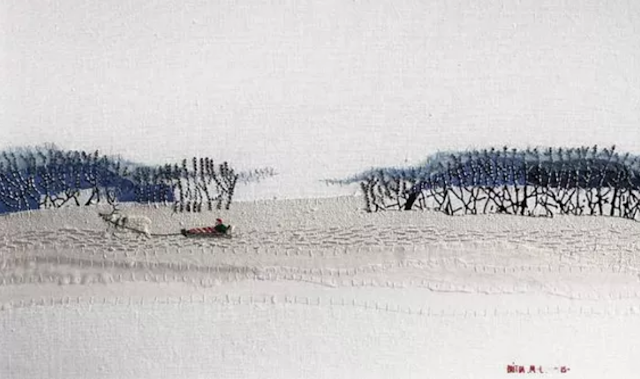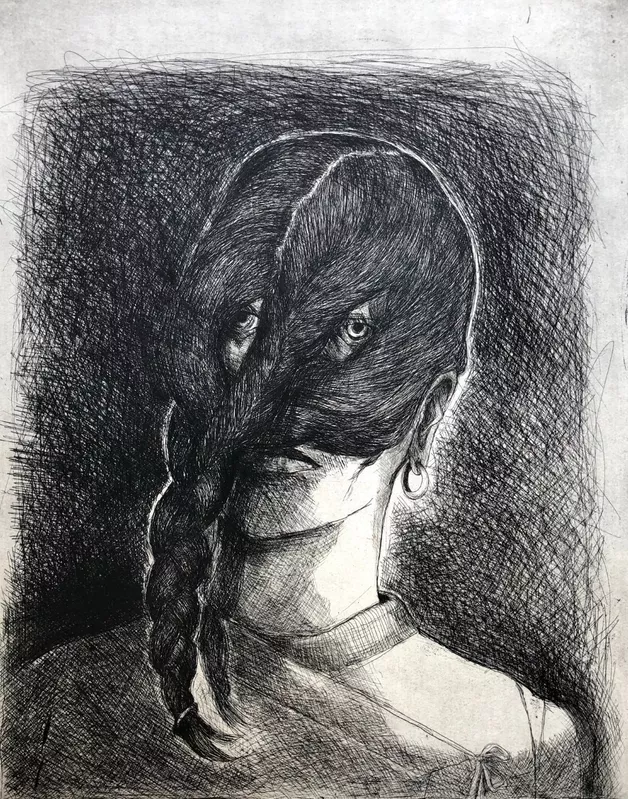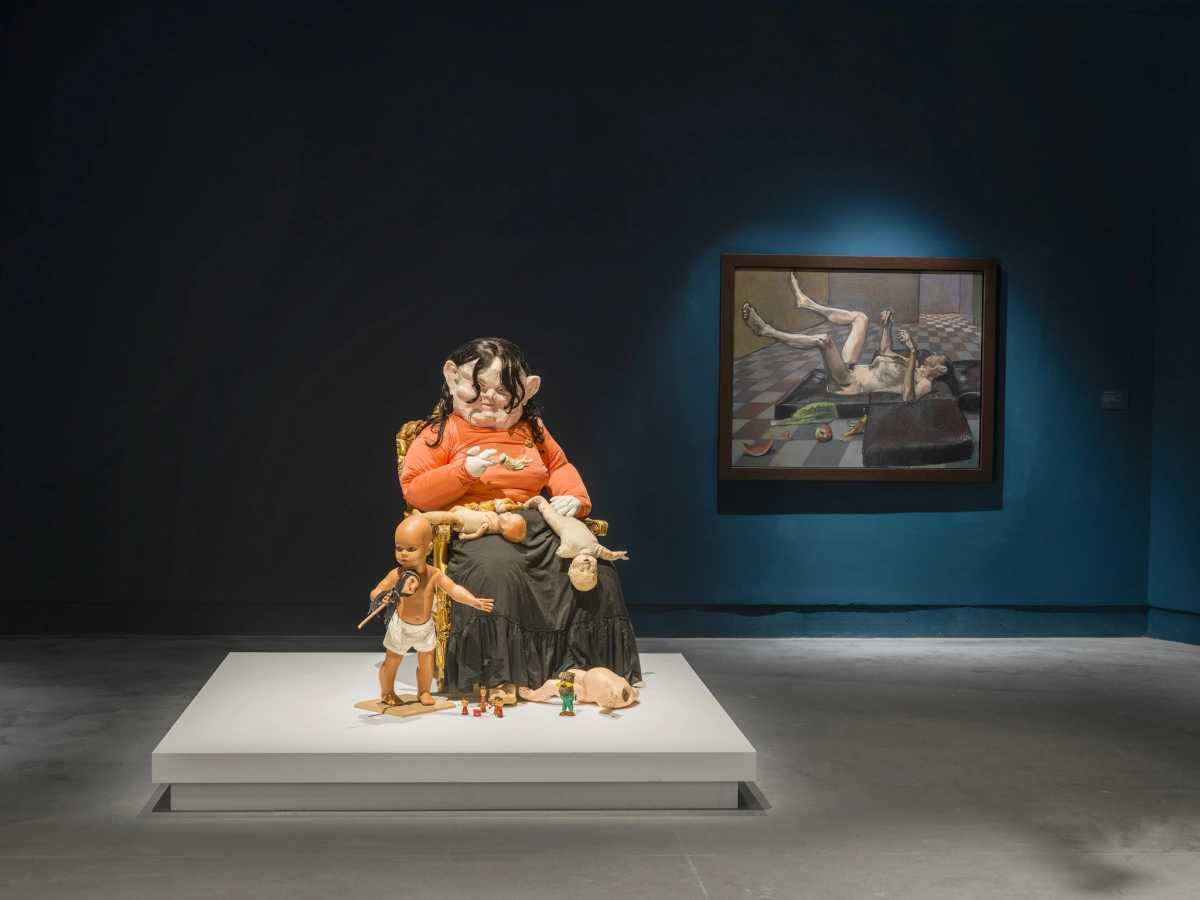Belkis Ayón
The Venice Biennale has returned however before reflecting on the work I ought to raise a few questions about my own decision to go there. I did wring several hands before deciding to go, because I had to fly and we all know how flying is a bad thing for the environment. But I haven't flown for three years and I decided that perhaps I could use this as a sort of last cheap travel trip and in future plan ahead much more carefully and travel by train. I did cost train travel for this year but it was far too expensive, and I only had a weekend window to go, however it was a last minute costing and I'm sure by careful planning I could have brought the costs down. So sorry about the hand wringing but it's I think going to be part and parcel of the process we will all have to go through as we develop changing travel mindsets to relation to our carbon footprints. The Venice Biennale is of course a product of the global art market and is a focus for international travel. As I wandered around looking at the art, I was also listening to the voices of people from all over the world; each one like myself deciding to travel long distances just to see what is happening in terms of art and how it reflects a certain zeitgeist of the times. How long we can afford to do this though I'm not sure and I expect there will be a global backlash against events of this sort that are put on with an expectation that people will still go, regardless of the environmental consequences.
For those of us like myself who are interested in drawing and its position as a thinking and visualisation tool it is fascinating to see how central it seems to have become again as a shaper of representations, in particular drawing's power as a tool to help mythic imagery come forth out of the unconscious mind and its ability to give form to and shape the images that emerge from materials play.
As you enter the first display in the Arsenale a huge Simone Leigh sculpture is surrounded by the visionary work of the Cuban printmaker Belkis Ayón. Her prints are collographs, a really basic printmaking method that I have advocated to students many times over the years as being a wonderful way of generating powerful images because it forces you to be very clear about the forms you use and therefore hopefully also monumental. She uses textural surfaces wonderfully and builds up her sometimes massive wall pieces by printing off images at approximately A1 size and then fitting them together to create the final composition. These sections are then tacked to the wall either as original prints or sometimes as photographs of the originals. The compositions when fitted together work very powerfully and you don't notice they are made up of sections because you are far too interested in looking at the imagery. The fact that sometimes she worked by fitting together blown up photographs of the sections reminded me about not being too precious about 'authenticity', if it works it works. Belkis Ayón was first asked to exhibit at the biennale in1993, but with limited means for the twenty-mile trip to the Havana airport, had to travel by bike with her father and they were late for the flight, however back then an anonymous Italian woman traveling from Cuba to Milan stepped in and paid for the work to be sent over. A reminder of how far things have changed in relation to air travel and the status of artists in what were often in the past called 'third world' countries.
Collography is a collage-like approach to printing, whereby surfaces are built up by cutting out various surfaces and gluing them down. You can then add texture by painting surfaces with substances such as glue mixed with sand and then when all is dry, you finally coat the whole thing with some sort of sealant, often a varnish or PVA. Once done these surfaces are inked up and used as surfaces to print from; this is the plate from which prints are made. If you dampen thick paper, so that when put under pressure after being laid over the collograph plate, it will press itself into the shape of the plate, it will both pull off ink in sometimes quite unexpected ways and become a shallow relief which adds textural interest because light playing over the surface casts small shadows from the indentations. This gives the artist a vast range of tonal and textural possibilities. Ayón’s prints have made the most of the subtle gradations of blacks, whites, and greys that the technique makes possible, the final images having a gravitas and conviction that made them appear magical and transformative. She represents as imagery the codes, symbols, and tales of Abakuá, an Afro-Cuban society whose foundational myth is based on a woman’s act of betrayal and in Ayón’s prints Sikán, the Abakuá princess is often depicted with no other facial features except her eyes. This gives Sikán a mythical presence, one sometimes found in religious scenes, and at other times in episodes of Ayón’s actual life, the imaginative world and the real world becoming fused together as darkly lit dramas. These are drawn images at their most potent, the process of cutting out images in sections for collograph construction, making each figure clear and defined and yet at the same time texturally other worldly and flat. These figures are spirits forms, made to help us find a link between the everyday reality of the present and the world of myth and legend. However collographs have another aspect to them that is often forgotten. They are usually made from what is thrown away, especially cardboard, bits of plastic, old textile materials, basically anything that when stuck down on a flat surface makes an interesting texture. Therefore as a technique it can be a useful recycling tool, but it also represents the ability of the artist to transform the left over surfaces of everyday materials into images of mythic potential.

Sometimes Ayón's prints were basic A1 size and if so these were framed.
Seen up close you can see the textural possibilities of collogaphs, the ink when wiped off a surface collects around the edges or when rolled on, sticks only to high points. For a pure white I would sometimes keep a cutout shape away from the inked surfaces until just before printing and then just lay it into place, finally laying the dampened printing paper on top.
For larger prints the images are cut out and mounted onto foam-board and then attached to the walls by 'L' hook screws.
This is composed of 9 roughly A1 sized collograph prints
Details showing how you can paint with glue and sawdust and other mixes to make a surface and then when dry and hardened these can then be inked up and printed off as powerful textures.
Sometimes these large images were made up of digital prints taken from photographs of originals stuck directly onto the walls
Detail of textures
In some ways very similar but visually in direct contrast to Belkis Ayón is the work of Britta Marakatt-Labba. She is a storyteller of the Sámi People. Her work is very easy to miss, being composed of tiny textile images made in delicate embroidery. However they can draw you in as a relief to the bombast surrounding them, but you do have to make an effort to readjust your aesthetic settings. Large walls and big exhibition spaces have over the years accustomed us to work designed to hold its own in these spaces and work made for domestic settings was in many ways pushed out and regarded as amateurish. I remember being told as a young artist that I couldn't be a professional until I had a studio large enough to be able to make work that would command a large gallery wall. Part of the legacy of 'macho art' are these huge spaces and I would like to feel that the inclusion of Marakatt-Labba and other artists who work at a similar scale, questions the need for such grandeur, especially when we are so aware of finite resources and the need to be very careful about how we use the resources we have left.
Britta Marakatt-Labba
Detail
Her embroidered snow and reindeer textures are evocative of both temperature and scale. These are tiny images but they invoke intimations of landscapes of vast size. The minuscule sledge being pulled across the image above follows in the ruts and furrows of others that have crossed this landscape before. All this of course evoked in a few threads of embroidery. Her economy of both scale and material use is extraordinary and a lesson to us all.
Britta Marakatt-Labba
I particularly liked the image of an isolated dark figure lost in a field of snow. There hadn't been an attempt to copy the texture of snow, instead she had substituted it with a texture made from the surface she was working on. The 'too large' texture worked very well as both an evocation. of a field of snow and as a reminder of what it feels like to be out in snow as it falls.
Like most of the artists in this year's biennale Britta Marakatt-Labba and Belkis Ayón are both women. There has been a focused attempt to redress the balance of well over a hundred years of male dominated exhibitions and this is a welcome reminder that when the Venice Biennale was founded most women didn't even have a vote and that women's rights have been hard fought for. The biennale title, 'The Milk of Dreams' is a quote taken from the work of Leonora Carrington, a Surrealist who when I began exploring the history of art back in the 1960s was regarded as a minor figure, but who has been undergoing a period of reassessment now that we have an awareness of how patriarchal most art collections are. There is also another issue going on here, and that is an attempt to communicate something about the nature of art made by women. This I would add is contentious, because in gendering things, you have to be careful that you don't fall into the trap of repeating the old stereotypes, this time from a female perspective. This is I would have thought particularly difficult during a time of gender re-assessment and the development of non-binary attitudes towards the dialogues surrounding the representation of sexuality. On the one hand I welcome the inclusion of such wide ranging content and a focus on artists exploring the unconscious and mythical aspects of our various societies. But I don't think we should be saying that women are more spontaneous or connected to mythic roots than men. The Earth Mother figure is a powerful one, but not one that every woman is. For instance the biennale could have also reminded everyone that scientific and hard nosed investigation can also be done by women. Someone like Hanne Darboven would have been an interesting artist to put into the mix, her mathematical rigour was almost myth like in its intensity and this could have been played off against artists such as Hilma of Klint or Louise Despont, both of whom are mythical in intent, but in no way could you call them Earth Mothers. I just wanted a more balanced view of what it is to be a women artist. At the end of the day all artists are individuals and no matter how hard curators try to shoehorn people into categories, they will escape them simply by virtue of art being open to what Gombrich called the beholder's share. So forgive me if when I focus on certain work I do it very much from my own point of view, however as always with my reports from Venice I hope they give a flavour of what to expect and over the next couple of weeks I shall report on other artists that I was interested in. The biennale exhibitions are on until November and I'm very aware that my university will be having a trip over to Venice before it closes. So do think about going, as it does give you a chance to look at a huge collection of art in the flesh, and after three years of being restricted to looking at a screen, it was a welcome reminder of how much more interesting it is when seen in its raw, physical reality.
See also:
Venice Biennale 2022 Part two
Venice Biennale 2022 Part three
Venice Biennale 2022 Part four
Reflections on other Venice Biennales
2017
Venice an allegory
Part 1
Part 2
Part 3
Part 4
2015
Part 1
Part 2
Part 3
Part 4




















































